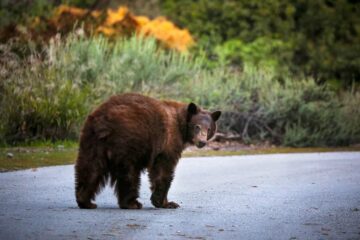Thousand Oaks considers taking action to discourage use of rodent poisons that kill wildlife
Experts say anticoagulants harm local wildlife
Source of this article: The Thousand Oaks Acorn, March 19, 2015
The Thousand Oaks City Council is considering a resolution that would urge businesses not to sell and residents not to use a type of rodent poison that’s being blamed for harming local wildlife.
The resolution before the council would discourage use of anticoagulant rodenticides, which are used to killed rats, gophers, ground squirrels and other rodents but end up hurting predators that rely on these animals as a source of food.
Once the bait is placed, rodents may consume the lethal pellets multiple times. Those poisoned rodents may be eaten by pets or wild animals, which can then become ill and even die, said Kevin Wilson, the city’s landscape supervisor.
“There have been a number of studies done that show anticoagulant rodenticides do adversely impact wildlife, birds, bobcats, mountain lions, coyotes,” Wilson said. “The animal you’re trying to control feeds and goes back and feeds again (on poison). They develop a massive amount of the poison in their system (and) don’t necessarily go back into their burrow or wherever they’re living to die. They wander around in a stupor and are easy targets for a bird of prey or bobcat.”
The resolution, which was set to go to the council at its March 3 meeting, will instead be considered Tues., April 14. The March 3 meeting was canceled because two of the four council members could not attend.
Only the U.S. Environmental Protection Agency and the state Department of Pesticide Regulation, not local agencies, have the legal authority to ban rodenticides.
The city stopped using anticoagulant rodenticides a year ago in the maintenance of city facilities and landscaping, Wilson said. The resolution to be approved by the council would officially direct city staff to stop using them in its maintenance of city facilities and landscaping unless there is a severe threat to public safety. It asks businesses and residents to do the same.
“The resolution will have some language that if I deem an infestation of rodents to be extreme and to be causing a public health safety concern, that we could utilize anticoagulants on a very limited basis and it would be heavily monitored,” Wilson said.
“That would be under very extreme circumstances, where perhaps a hillside was becoming severely eroded and it was in jeopardy of collapse. Or, God forbid, if we ever had an outbreak of bubonic plague, we could treat the rodents with the anticoagulants.”
More than 20 cities and counties in California have adopted resolutions regarding anticoagulant rodenticides that ask businesses and residents to curb their sale and use.
Types of rodenticides
There are two types of anticoagulant rodenticides: first- and second-generation. The more toxic second-generation rodenticide was created because animals were building a resistance to the first generation poison, Wilson said.
It was registered as a restricted material by the California Department of Pest Regulation in July 2014, meaning it can be purchased and used only by a licensed pest control company.
To ensure the safety of children or pets who might ingest the poison, both types were designed to take effect only after multiple feedings, Wilson said.
“When they were developed, there was a concern that children or domestic animals would eat them and die,” Wilson said. “In order to prevent instant death, they designed them to be multiple feedings, so that if somebody was to accidentally ingest one, it wouldn’t kill them.”
To control rodents, the city has been using snap traps and Fumitoxin, a fumigant that can be applied inside a burrow by a licensed operator, Wilson said.
But many restaurants place bait stations that contain anticoagulant rodenticides outside their establishments. Wilson suggests restaurants use snap or electric traps, even though they cost more money because pest control employees have to clear the traps.
“I believe that as good custodians of our planet and our environment, that little extra cost is worth it to keep the wildlife free of being poisoned with anticoagulants,” he said.
Wilson plans to offer classes covering the city’s new rodenticide policy and adoption of other environmentally safe practices.
“We get feedback from residents all the time. More and more the consensus is that the people of Thousand Oaks want to stop using anticoagulants,” he said. “People are becoming more aware that some of these chemicals we’re using are not good for the environment. There are other alternatives that are probably just as effective.”
In a letter to council members, T.O. resident Conilee Kirkpatrick encouraged their support of the resolution.
The letter said, in part, “We need your support for educational outreach to make our citizens and businesses aware that the use of these poisons and bait boxes is not effective in reducing rodent populations, but in fact reduces the populations of their predators. Removing the food sources, by trash/garbage management, keeping dumpsters closed and secured, and feeding pets indoors are much more effective in suppressing rodent populations.”
The April 14 City Council meeting begins at 6 p.m. inside council chambers, 2100 E. Thousand Oaks Blvd.



0 Comments